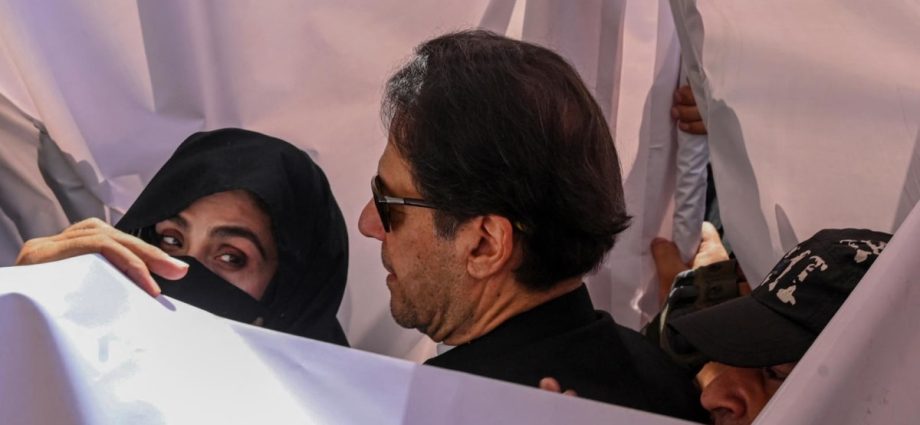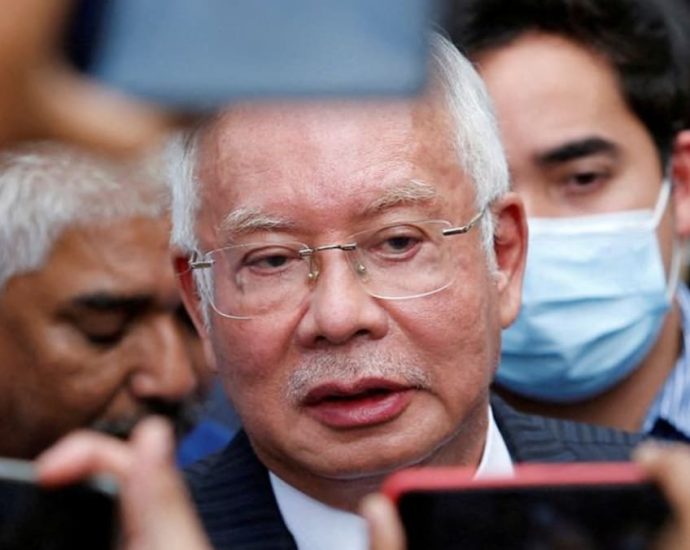Pakistan ex-PM Imran Khan and wife get 14 years jail in graft case
ISLAMABAD, Pakistan: Former Pakistan prime minister Imran Khan and his wife were sentenced on Wednesday (Jan 31) to 14 years in jail after being found guilty of graft in a case involving gifts he received while premier. The verdict, a week before national elections, comes a day after Khan wasContinue Reading
Myanmar hands over three junta-backed Chinese warlords to Beijing
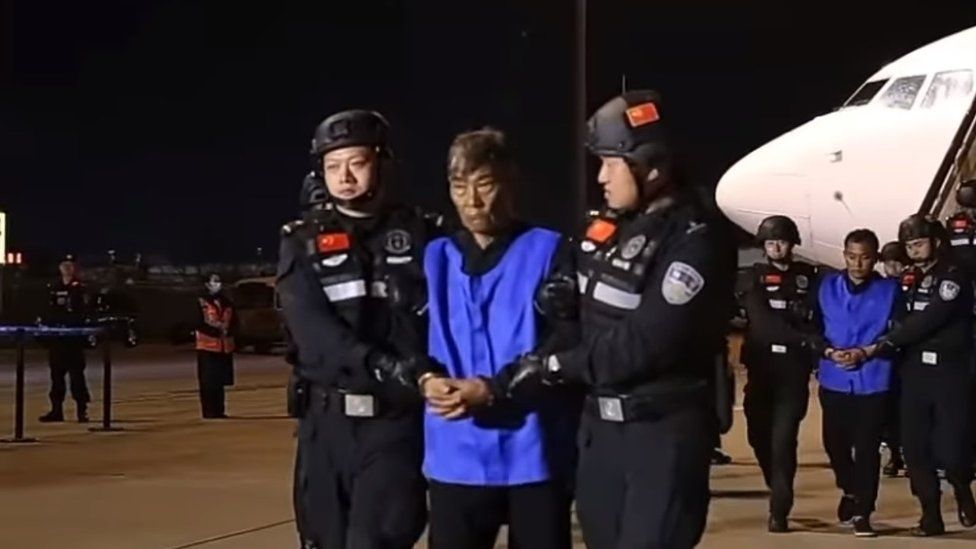 Eastern Broadcasting Company
Eastern Broadcasting CompanyMyanmar has handed over three Chinese warlords to Beijing, who were notorious for running scam centres that trapped more than 100,000 foreign nationals.
Bai Suocheng, Wei Chaoren and Liu Zhengxiang led three of four families which ruled Laukkaing on Myanmar’s north-eastern border with China.
They were were taken to China on a chartered flight, with seven others.
This is the latest twist in the stunning downfall of the military-backed Chinese mafia in Myanmar.
And it’s yet another blow for Myanmar’s military regime, whose power is waning.
Myanmar’s army, which had been locked in a brutal stalemate since it sized power in early 2021, is now losing as it battles well-organised ethnic armies on more than one front.
General Min Aung Hlaing is known to have supported the Chinese mafia in Laukkaing. For years, China had been pressing his regime to rein in the scam centres but with little success.
China’s unease encouraged three insurgent armies to launch coordinated attacks against the military in late October last year – and hastened the fall of the mafia families.
The four families took over control of Laukkaing in 2009. Liu Guoxi, who led the fourth family, died in 2020.
Over the years, their reign turned a poor Burmese border town into a den of criminal activity, especially for lucrative scam centres. The UN estimates that hundreds of thousand of people have been trafficked into these centres across South East Asia.
“For a long time, multiple criminal groups… in northern Myanmar have openly organised armed fraud gangs and carried out telecom fraud crimes against Chinese citizens,” China’s Ministry of Public Security said on Tuesday. Telecom fraud refers to the scams that people trapped in the scam centres were being forced to run.
They are also accused of “multiple and severe violent crimes”, the ministry said, such as murder, assault and illegal detention.
In December, Beijing issued a public reward for these men and others in their network, describing them as “ring leaders” and sent a team to Myanmar to work with local authorities there.
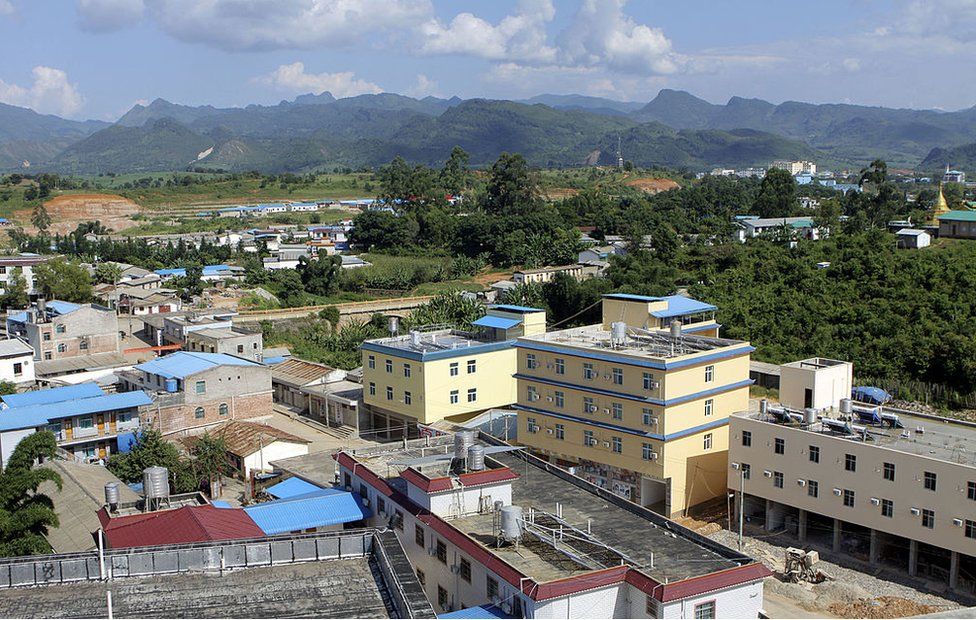
A vulnerable Myanmar army allowed China the opportunity to crack down on the scam compounds in Laukkaing.
About 44,000 people suspected to be involved in the scam centres have been handed over to China from Myanmar so far, the Ministry of Public Security said.
But China called Tuesday’s development – the arrest of the three heads of the mafia families – a “landmark achievement”.
Footage aired on Chinese-language TV channels show dozens of Swat (Special Weapons and Tactics Unit) officers escorting suspects down the plane in Kunming and into police vans.

The Godfather(s) of Laukkaing
By Jonathan Head
With their close ties to the military, the Godfather-esque “four families” in Laukkaing developed extensive business networks in Myanmar, with stakes in mining, energy, infrastructure and casinos in other countries like Cambodia. They established links with organised crime networks in Macao and south-eastern China.
Under them the remote, impoverished backwater of Laukkaing was transformed into a rowdy casino hub of gaudy high-rise towers and seedy red-light districts.
Initially developed to take advantage of Chinese demand for gambling, which is illegal in China and many other neighbouring countries, Laukkaing’s casinos evolved into a lucrative front for money laundering, trafficking and in particular for dozens of scam centres.
More than 100,000 foreign nationals, many of them Chinese, were estimated to have been lured to these scam centres, where they were effectively imprisoned and forced to work long hours running sophisticated online fraud operations targeting victims all over the world.
Laukkaing took on the character of a Wild West boom town, where anything goes and anything can be bought and sold. There were occasional gun battles between rival scam centres, and powerful people kept lions and tigers as pets.
Read more on the ignominious end to a story that began in the days of revolution, but turned into one of drugs, gambling, and greed.
Related Topics
-
-
9 November 2023

-
-
-
18 June 2023
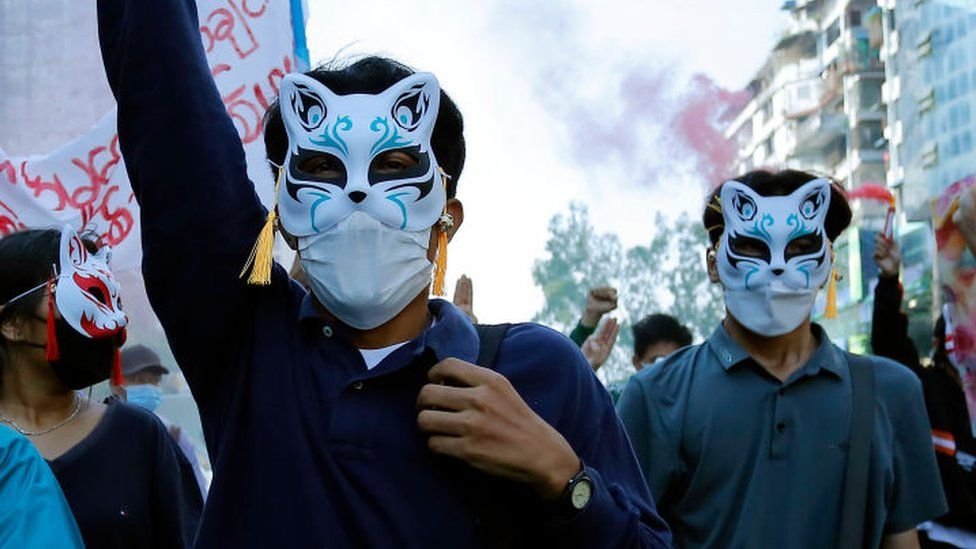
-
-
-
17 April 2023
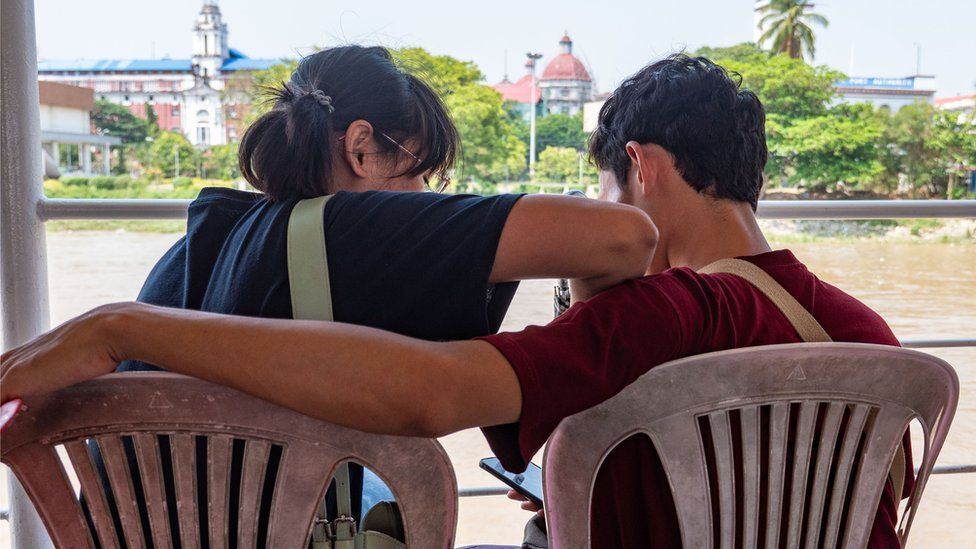
-
Pink Line to resume full service
PUBLISHED : 31 Jan 2024 at 13:51

The Pink Line monorail will resume full service from Min Buri to Nonthaburi Civic Center on Thursday after its operator repaired a conductor rail that collapsed last month.
Inspecting the system on Tuesday, Deputy Transport Minister Surapong Piyachote said Pink Line developer and operator North Bangkok Monorail Co had completely repaired the conductor rail and the entire line was tested successfully on Wednesday.
At about 5am on Dec 24, 2023, a five-kilometre-long section of the conductor rail fell from the elevated structure of the Pink Line, from the Central Chest Institute of Thailand near the Khae Rai station to a pocket track (centre siding) near the Royal Irrigation Department station.
The conductor rail hit several parked vehicles on Tiwanon Road in the early hours of Christmas Eve.
Officials determined that the conductor rail was hit and dislodged when sheet piles were being lifted by cranes. An empty monorail train on a test run then pulled the rail down shortly before trial service was to start at 6am that day.
The 34-kilometre-long Pink Line links Bangkok’s northern district of Min Buri and Muang district of Nonthaburi to the west of the capital.
Competition watchdog begins in-depth review of Grab’s proposed Trans-cab acquisition

Grab and Trans-cab have argued that the acquisition will not result in a substantial lessening of competition, citing “minimal overlaps” between them; a lack of prohibitive barriers to entry; and a highly fragmented and competitive rental market.
On Oct 31, 2023, Grab proposed some commitments to address the competition concerns identified by CCCS.
“CCCS reviewed the commitments proposal and found that, without the benefit of an in-depth review, it was unable to conclude that the commitments proposal adequately addressed the competition concerns CCCS identified,” said the watchdog on Wednesday.
“For example, it did not adequately address the concern that the proposed acquisition may give Grab the ability and incentive to leverage its ownership of the Trans-cab fleet to induce Trans-cab drivers to use Grab’s ride-hail platform, whilst discouraging them from using rival ride-hail platforms.”
The tech firm’s proposed commitment duration of two years, as well as their self-policing monitoring mechanism, were also deemed to be insufficient, said CCCS, adding that Grab was informed on Nov 24, 2023 that it could not accept the proposal.
Grab had argued that the merger would ultimately benefit customers and improve driver earnings.
“Digitalising Trans-cab’s fleet will improve driver productivity and taxi availability so that consumers can get a ride more easily,” Grab said in October.
The company also said that Trans-cab drivers will still have the option of being on multiple ride-hailing platforms and pick up street hail rides.
China overtook Japan as world’s top vehicle exporter in 2023
TOKYO: China overtook Japan as the world’s biggest vehicle exporter last year, data from the Japan Automobile Manufacturers Association (JAMA) showed Wednesday (Jan 31). Japan shipped 4.42 million vehicles in 2023, the figures showed. That compared with 4.91 million exported by China, as reported by the China Association of AutomobileContinue Reading
What does Evergrandeâs liquidation mean for other property developers in China?

The liquidators could propose a new debt restructuring plan if it is determined that the Guangzhou-based firm has enough assets or if a white knight investor emerges. They could also refer suspected misconduct by directors to Hong Kong prosecutors.
The process, however, could be complicated, and face cross-jurisdictional issues as most of the developer’s assets are located in mainland China, said experts.
It is not clear whether the Hong Kong court order could be enforced onshore, Dr Wu told CNA’s Asia Now on Monday.
“Hong Kong and mainland China are two different jurisdictions, so this will be a challenge,” he said.
“If there’s no court in mainland China that actually recognises this Hong Kong court case, then perhaps there are limited things that the provisional liquidator in Hong Kong can do.
“(Even) if there is a court in mainland China that actually does recognise this court case, I think this will still be a long, drawn-out process.”
Imran Khan: Former Pakistan PM jailed another 14 years for graft

Imran Khan and his wife Bushra Bibi have been sentenced to 14 years in prison, a day after the former Pakistan prime minister was jailed for 10 years.
Khan, who was ousted as PM by his opponents in 2022, is already serving a three-year jail term after being convicted of corruption.
On Tuesday he was sentenced for leaking state secrets, and on Wednesday given another 14 years for a graft case.
Khan has said the numerous cases against him are politically motivated.
These latest convictions come just a week ahead of Pakistan’s national elections in which he is barred from standing.
It is believed that the sentences will be served concurrently. Khan has already been detained since last August when he was arrested.
His wife Bushra Bibi had been on remand during the trial – which pertained to allegations the couple had illegally sold state gifts they’d received for personal profit.
This breaking news story is being updated and more details will be published shortly. Please refresh the page for the fullest version.
You can receive Breaking News on a smartphone or tablet via the BBC News App. You can also follow @BBCBreaking on Twitter to get the latest alerts.
Related Topics
Former Malaysian premier Najib Razakâs jail term halved from 12 to 6 years, say official sources
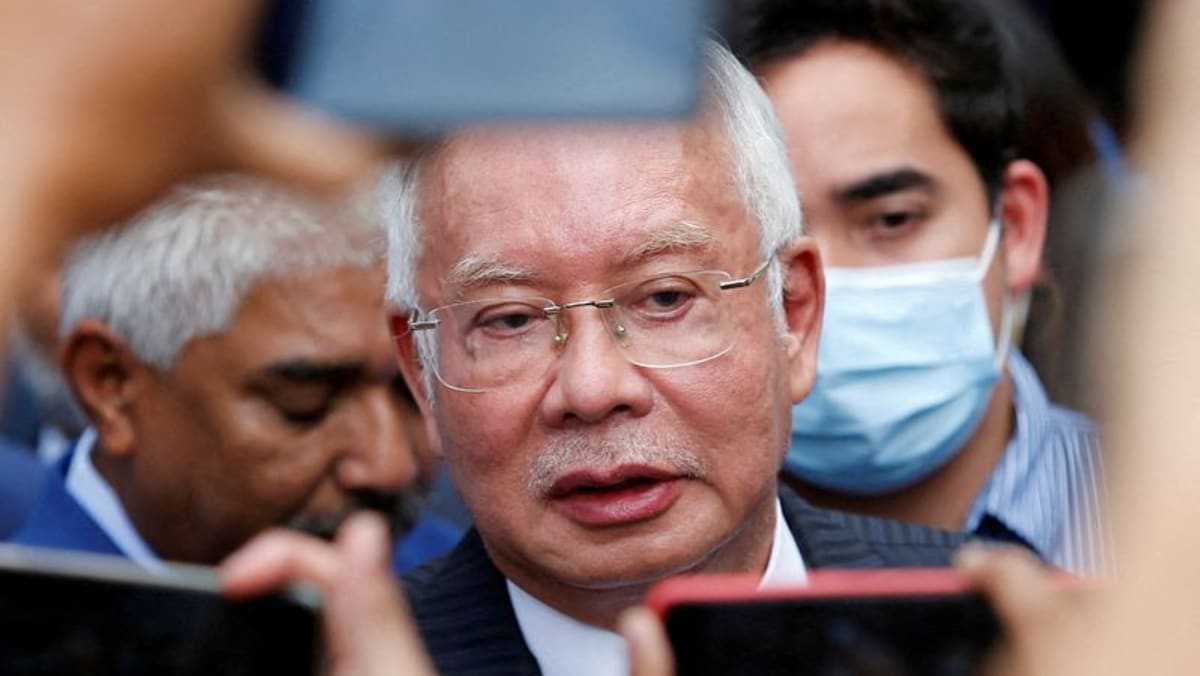
KUALA LUMPUR: Former Malaysian prime minister Najib Razak’s jail sentence for corruption has been reduced from 12 to six years by the Pardons Board following its meeting on Monday (Jan 29), sources including senior government officials told CNA.
The decision by the board, which is headed by Malaysia’s king, includes a reduction of his RM210 million (US$44.4 million) fine to an unspecified amount, according to three separate sources who spoke on condition of strict confidentiality.
The partial royal pardon for his role in the 1Malaysia Development Berhad (1MDB) case comes after serving less than two years of his prison term.
The reduction means Najib is expected to complete his sentence in August 2028. But with parole for good behaviour, he could be out in August 2026 after serving two-thirds of the new jail term.
There has been feverish speculation about the pardon after Dr Zaliha Mustafa, Minister in the Prime Minister’s Department (Federal Territories) confirmed on Tuesday that the board members including herself had met on Monday. She said an official announcement by the Pardons Board will be made.
The meeting was one of Sultan Abdullah Ri’ayatuddin’s last official tasks before he stepped down as Malaysia’s king on Jan 31 and handed the role to Johor ruler Sultan Ibrahim Sultan Iskandar under the country’s unique rotation system for its nine royal state households.
CNA is contacting the Malaysian authorities for comment. Najib’s lead counsel Muhammad Shafee Abdullah said he has yet to be informed of any decision by the Pardons Board.
NAJIB’S INFLUENCE AND OUTSTANDING CHARGES
Najib, an ex-United Malays National Organisation (UMNO) president, is still believed to wield huge influence in the party, which is part of Prime Minister Anwar Ibrahim’s unity government.
He was Malaysia’s premier for nine years until May 2018 and its first PM to be imprisoned. He began serving his jail term in August 2022 after two failed appeals to overturn his conviction at a Malaysian High Court two years earlier.
The charges involved the transfer of RM42 million from SRC International, a former subsidiary of 1MDB, into his personal bank accounts in 2014 and 2015.
He was found guilty of three counts of criminal breach of trust, three counts of money laundering and one count of abuse of power by the High Court in July 2020, and was sentenced to 12 years in jail and fined RM210 million. The fine remains unsettled.
He is also facing several other charges in relation to the 1MDB scandal, including the laundering of RM27 million involving funds from SRC International.
Najib’s lawyers have applied to dismiss this money laundering case, and the court has said he can apply for an acquittal, or a discharge not amounting to an acquittal if prosecutors are not prepared to proceed with the trial in September, local media reported.
1MDB, Najib’s brainchild shortly after he became premier, turned into one of the biggest scandals to rock Malaysia and the international financial community. United States and Malaysian investigators estimate that more than US$4.5 billion was stolen from the fund and another US$1 billion flowed into accounts held by Najib.
Just days after Najib began serving his sentence at the Federal Prison of Kajang on the outskirts of Kuala Lumpur, he applied for a royal pardon.
CNA previously reported that Najib’s lead counsel Shafee filed a fresh application in early December last year for the Pardons Board to revisit his client’s clemency application.
This led to the change of heart among certain members of the Pardons Board, government officials close to the situation noted without elaborating. The application came before the Pardons Board in a meeting in December, but the matter was deferred to January.
Malaysia is a constitutional monarchy, giving the king the final word on the pardon of convicted criminals, a similar system that governs neighbouring Thailand.
Manager of lending firm arrested for stealing customers’ money
PUBLISHED : 31 Jan 2024 at 12:47

BURI RAM: The manager of a lending company has been arrested for stealing almost 200,000 baht from its customers’ accounts.
The manager allegedly used the documents of three customers to change their personal data, allowing him to obtain cash cards that were then used to withdraw money from the victims’ loan accounts.
Investigators from Provincial Police Region 3 and local police, armed with an arrest warrant issued by the Buri Ram Provincial Court, arrested a man identified only as Anurak, 32, the manager of a lending firm in Muang district on Wednesday, police said.
The arrest came after three people who were customers of the lending company filed a complaint with police at Muang police station that someone had used their names to apply for cash cards that were used to withdraw money they transferred to the company for loan repayments. This caused their outstanding debt balances to be inaccurate.
Almost 200,000 baht had been withdrawn from their loan accounts in December last year despite the fact that they had no cash cards to withdraw the money.
Following a police investigation, officers sought court approval to arrest Mr Anurak, who worked as the manager of the lending firm where the victims received loans.
Police said that on seeing the arrest warrant, Mr Anurak admitted to having withdrawn money from his customers’ loan accounts. Police searched his room and seized clothes he wore when going to withdraw cash from ATM booths, as captured in footage from closed-circuit television cameras.
A mobile phone and a pickup truck were also seized from him, but the cash cards he obtained under the victims’ names were not found. He claimed he had thrown them away and could not remember where.
During questionining, he said he had worked at the lending company since it was established. He later found a way to steal money from customers’ loan accounts by using the personal documents submitted to the firm. He had used those documents to change the customers’ mobile phone numbers and other personal data before applying for cash cards on the victims’ behalf. He then used the cards to withdraw money. He claimed he was motivated by informal debts that he was unable to pay.
Police charged him with theft and illegally using others’ electronic cards to cause damage to other people.
Sydney Harbour shark attack victim Lauren O’Neill thanks ‘heroic’ neighbours
 Supplied
SuppliedAn Australian woman attacked by a bull shark in Sydney Harbour has thanked her “heroic” neighbours for coming to her aid.
Lauren O’Neill was bitten during a sunset swim near a wharf on Monday.
The 29-year-old’s leg was severely injured but surgeons worked through the night to save it from amputation, according to Sydney’s Daily Telegraph.
In a statement on Wednesday, Ms O’Neill lauded the life-saving help offered by onlookers, medical staff and police.
She said she had been taking a “short dip” close to the shore in Elizabeth Bay after a hot day – as she often did – when she was attacked.
“She wishes to thank her heroic and very kind neighbours for the critical assistance they provided her,” said a statement released by the hospital where she is receiving care.
Local media have reported that the keen kayaker and swimmer lived near an ocean pool equipped with shark nets but often swam in the open water.
Witnesses have said they rushed to the scene and applied first aid after hearing her yelling. They helped Ms O’Neill out of the water and one woman – a vet – applied a tourniquet to stem the bleeding, something credited with potentially saving her life.
Ms O’Neill said she was “immensely grateful” to paramedics and police for their “swift and caring actions at the scene” as well as the medical teams treating her.
“Her likely full recovery is testament to their extraordinary skills,” the statement said.
She also thanked her loved ones and the public for their support, but requested privacy as she recovers.
Sydney Harbour is a well-known habitat for bull sharks, but attacks in the area are rare.
Experts have reiterated warnings to locals to stay out of the harbour on hot days and at dawn or dusk – times of greater shark activity.

